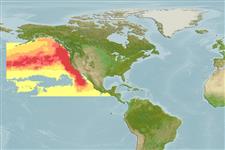Actinopterygii (Straalvinnigen) >
Perciformes (Perch-likes) >
Carangidae (Jacks and pompanos) > Caranginae
Etymology: Trachurus: Greek, trachys, -eia, -ys = rough + Greek, oura = tail (Ref. 45335); symmetricus: From symmetricus which means regularly formed - referring to the rough tail (Ref. 6885).
Omgeving / Klimaat / Range
Ecologie
; marien; oceanodroom (Ref. 51243); diepteverspreiding 0 - 400 m. Subtropical, preferred 8°C (Ref. 107945); 65°N - 13°N
Eastern Pacific: southeastern Alaska to southern Baja California, Mexico and the Gulf of California; reported from Acapulco in Mexico and the Galapagos Islands.
Size / Gewicht / Leeftijd
Maturity: Lm ? range ? - 31 cm
Max length : 81.0 cm TL mannelijk/geslacht niet bekend; (Ref. 2850); common length : 55.0 cm TL mannelijk/geslacht niet bekend; (Ref. 9283); Maximaal vermelde leeftijd: 30 jaren (Ref. 766)
Dorsale stekels (totaal): 8 - 9; Dorsale zachte stralen (totaal): 28-38; Anale stekels 1-2; Anale zachte stralen: 22 - 33; Wervels: 23 - 25. Small specimens may have an additional forward-directed spine at first dorsal origin (embedded in larger specimens).
Adults are often found offshore, up to 500 miles from the coast (Ref. 9283). They form large schools (Ref. 2850). Young frequently occur in school near kelp and under piers (Ref. 2850). They feed mainly on small crustaceans and fish larvae (Ref. 9283). Large individuals often move inshore and north in the summer (Ref. 2850). Marketed fresh, smoked, canned and frozen; eaten fried, broiled and baked (Ref. 9988).
Eschmeyer, W.N., E.S. Herald and H. Hammann, 1983. A field guide to Pacific coast fishes of North America. Boston (MA, USA): Houghton Mifflin Company. xii+336 p. (Ref. 2850)
Status op de Rode Lijst van het IUCN (Ref. 115185)
CITES (Ref. 94142)
Not Evaluated
Gevaarlijk voor mensen
Harmless
Gebruik door de mens
Visserij: commercieel; vis voor de hengelsport: ja
Meer informatie
ReferentiesAquacultuurAquacultuurprofielKweeklijnenGeneticaAlleelfrequentiesErfelijkheidZiektenVerwerkingMass conversion
Tools
Speciale rapporten
Download XML
Internet-bronnen
